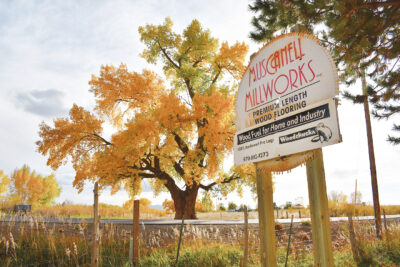
Guest Writer
Interest rates continue to be on everyone’s mind as we go into 2024. “We had a very good run in the lumber markets through November,” reported a Quebec producer. “We have seen a substantial price appreciation. That was a rally that lasted three to four weeks. The interesting part is that going into December, although the rally softened a little bit, prices held, which is a good sign going into the end of the year here.”
Noted one Ontario manufacturer, “This is a nice way to start towards 2024. One of the reasons for this good stretch is that there’s better balance right now between demand and production. There’s been some production cuts in both Eastern and Western Canada and that has had an impact on the availability of some commodity products. This is really helping the marketplace at this point in time.”
Reported a Quebec manufacturer, “What remains a staple, a leader in the market, is No. 2 and Better, 2×4-16 is very strong right up to today. It is selling nicely. We are hearing that people are selling it over print price for the 16s, you know, the Great Lakes price. People are selling several dollars over that with ease at the moment, which is unusual.
Usually we do get these periods where that product is successful, but it gets caught up, there’s a lot of pressure coming from offshore, for example, Euro wood often in the US that comes and spoils the rallies for Canadian and US lumber producers, but in this particular case, it seems to be holding again. It speaks to the fact that there’s good supply/demand balance in the marketplace.”
“In general 2×4 randoms and 2×6 randoms in No. 2 are strong and, in some lengths, No. 3 is strong, and both 2×4 and 2×6. So those are the leaders,” according to an Ontario wholesaler.
Noted a Quebec wholesaler, “The economy grade as well, 2×4, 2×6, is strong also. We’ve seen people coming back and looking for more constantly in these products, which is a good thing. It’s not a commodity, but it’s good to see it moving anyway.”
An Ontario wholesaler commented that “looking in my crystal ball, it’s an interesting one. With interest rates potentially stabilizing, if not decreasing in time, like maybe during the first quarter of 2024, it should help the market. Everyone is going to watch carefully to see where the housing start numbers were for November when they come out. That’s going to be a big teller as well as to what we’re going to see in the first quarter of 2024.”
A Quebec wholesaler commented, “It’s so difficult to predict as we have had so many things happen in the last couple of years, with interest rates and housing coming down and all of that. But, in the US there’s still a large deficit of rental units, for example, in many states. That has to be fulfilled at some point in time, so we believe that as soon as there’s a positive development with inflation, the market is going be fairly strong.”
On the Pine front, an Ontario manufacturer commented, “Well, it’s quiet for this time of year. As far as the market goes, the upper grades are still holding. There is softening in the lower grades, as we have seen in the recent past. There’s certainly a correction being done out there, but it’s not like nobody’s buying.”
Echoed a Quebec producer, “It’s a quiet time of year for sure, and that’s traditional in the annual cycle. But it certainly is really slowed down there. A lot of industrial guys that are using the low grade, they’re not busy, so demand is down, which means prices are softening because Spruce is low. Being that we are in White Pine and Red Pine, for them I mean, it’s a last resort. If they can’t find the Spruce, they’ll buy ours but Spruce is readily available and it’s cheaper right now.”
Reported a Quebec wholesaler, “As far as the low ends, that kind of drives the market down. But that being said, there’s really not much demand for it anyway. The uppers are doing okay still, they’re hanging in there for now. January will be slow as it typically is and usually about mid-February to March, the market starts to take off a little bit. I think we’re more back to pandemic times as far as demand goes. There’s no doubt that Canada is in a tough economic patch right now.”
An Ontario wholesaler reported, “I think things are going to be pretty much on the scale with what’s happening out there, but, I don’t think it’s going to hit rock bottom like we saw back in 2008. It’s certainly not going to be that bad.
As you would expect, consumers are definitely watching their pennies. With the interest rates going up, people aren’t building and the buying has slowed down. As far as the average person goes, if they have a project they want to do, they may put it off for a year or so. The cost of living – rent, mortgages, groceries – it is going to dampen any additional spending. It will improve when things start to settle down a little bit.”
According to an Ontario producer, “In terms of the coming months, lots depend on the retailers, what kind of optimism they have. So it’s a little early to tell right now, but if in fact there’s some indication that interest rates might be cut by mid-summer, it might help things along. I think for the next six months it’s going be kind of a slow demand. We can always hope, but lots of things will be beyond our control. You just have to go with the flow. You just hope that nobody out there starts pushing a panic button and dropping the prices that took very long to try to get up to where they should be. That’s the unfortunate thing. There’s always somebody out there that’s got themselves a bad situation and they push the panic button. That kind of sets the stage for everybody else.”
Noted an Ontario producer, “Our company is primarily producing grade lumber, not construction grade material. We find pricing has dropped a little bit from this time last year. Buyers are more specific on what they want. They have also delayed some of their larger green production orders for this year. If we see interest rates start to drop, then you’ll see the inventory of dry lumber get eaten up pretty quickly, and then we’ll probably see an increase in pricing to follow that.”
“We have seen a lot of construction jobs etc. that have been put on pause,” reported a Quebec-based wholesaler.
“And so basically if the interest rates improve, then you should start to see some better sales and probably some better pricing as well. It’s really going to be interest rate dependent, and obviously there’s a lot of global pressures on interest rates too that don’t help. So typically you hope for a drop in interest rates coupled with a lower Canadian dollar, that will be positive for us.”
An Ontario manufacturer mentioned, “Winter is your prime logging period. Now is always your premium time to log, when the ground is frozen and you can get into some of the softer areas. The climate warming makes it a more interesting, challenging thing. It depends on what weather we see. If you’re into a mild winter, you generally get a lot of snow that’s associated with that, and that’s obviously more of a problem trying to keep the roads sanded. To get in and out, there’s always extra cost there. But as far as when things actually break up, the logging usually stops by the 1st of March. Everybody’s got their wood forwarded out of the bush at that point where they can access it from the highway or a major roadway.”









